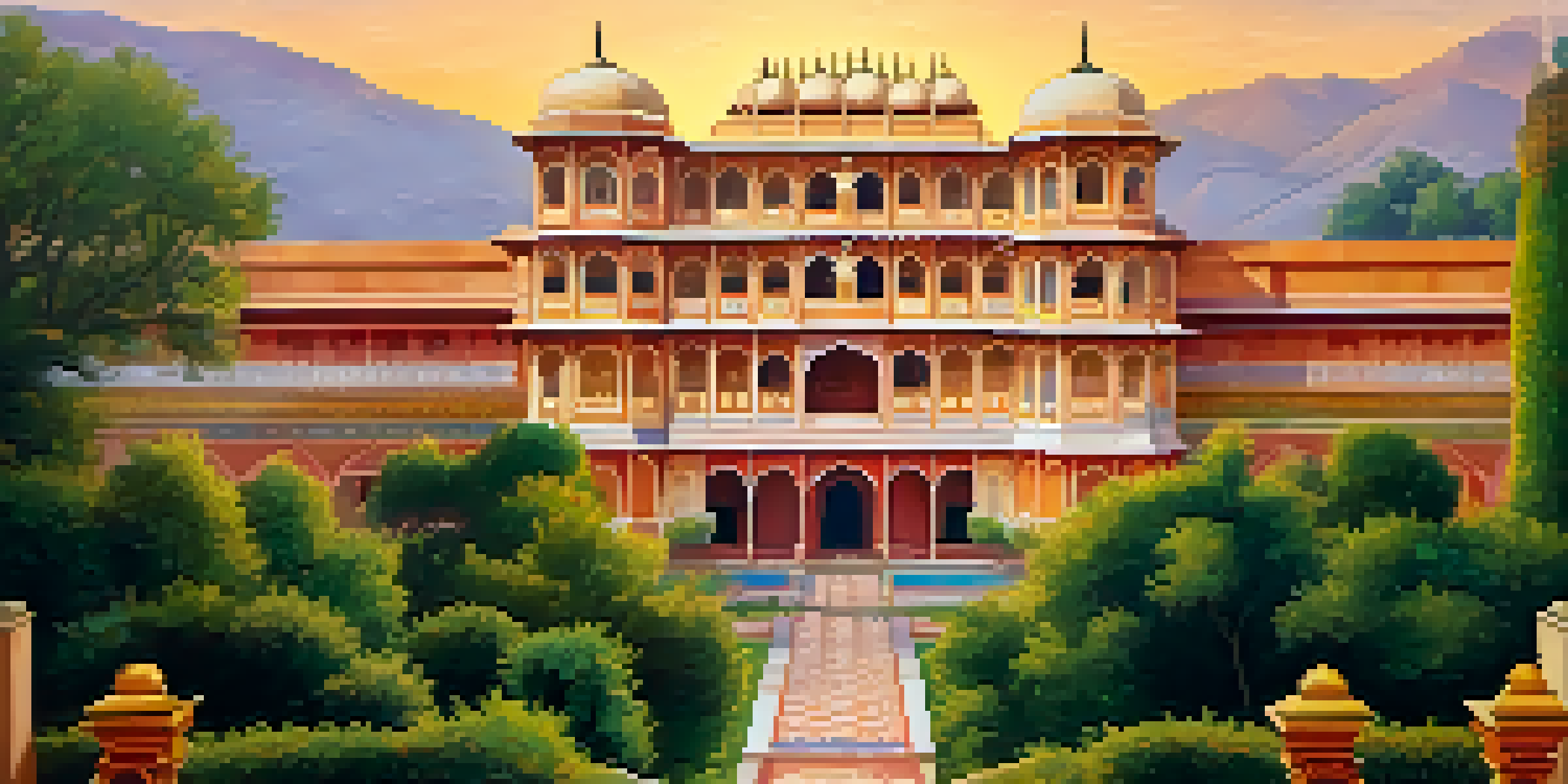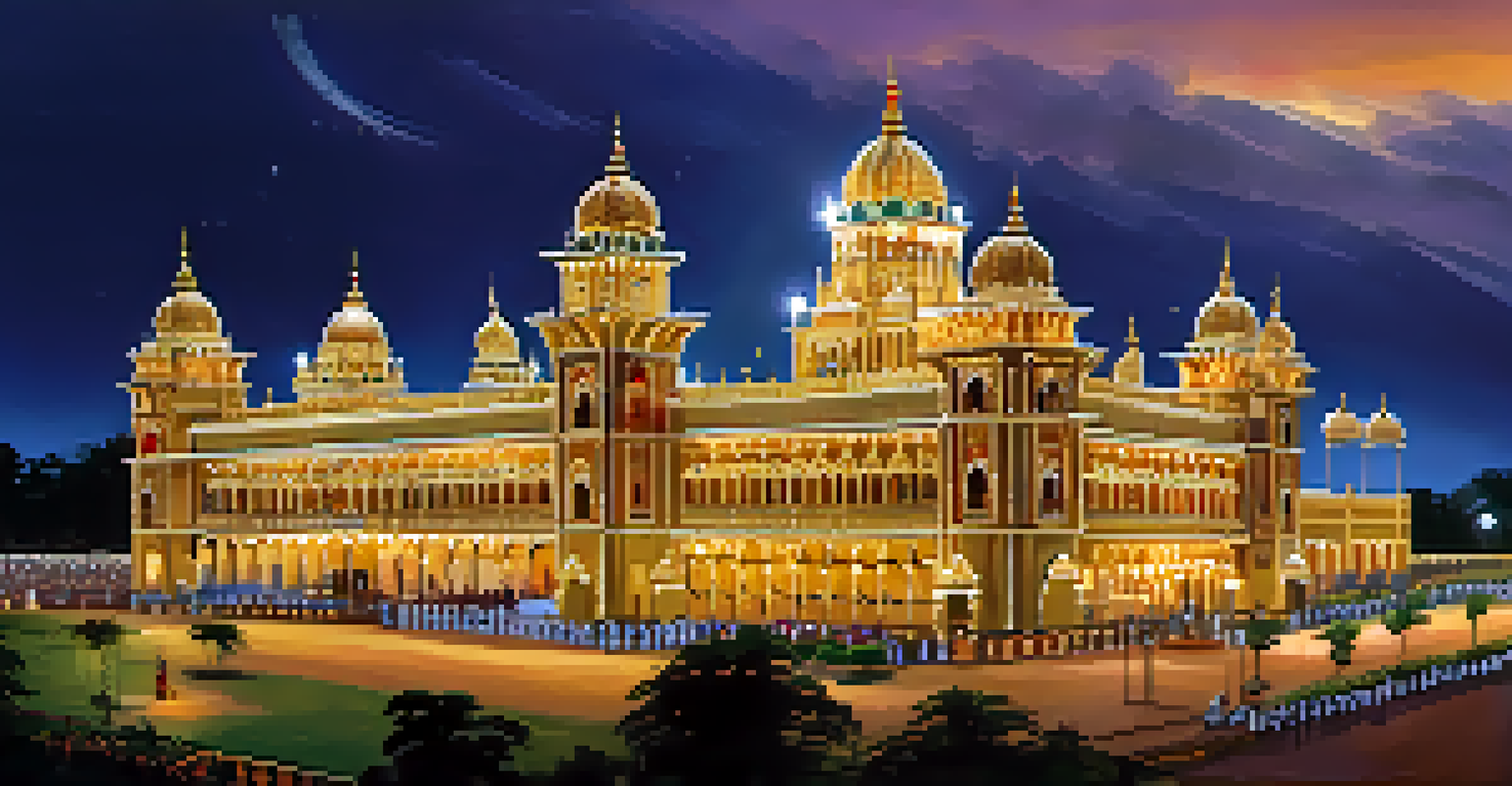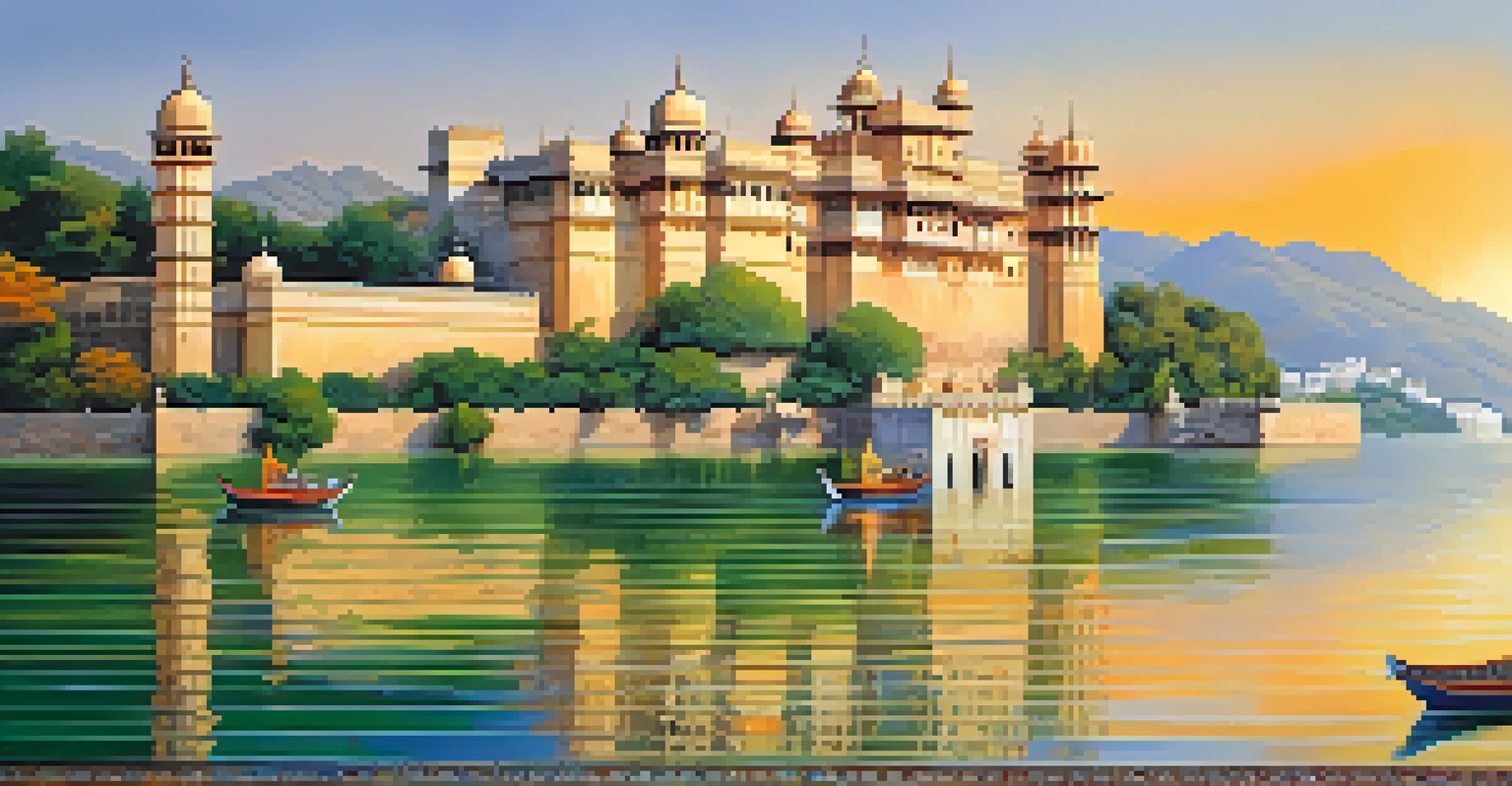The Best Royal Palaces to Experience India's Regal Heritage

Discovering the Grandeur of India's Royal Palaces
India is a land of rich culture and history, and its royal palaces are the crown jewels of this heritage. Each palace tells a story of its own, reflecting the opulence and architectural brilliance of various dynasties. From the intricate carvings to the sprawling gardens, these palaces capture the essence of regal life in India.
Architecture is the learned game, correct and magnificent, of forms assembled in the light.
Visiting these palaces offers a unique glimpse into the past, showcasing the lifestyles of kings and queens. Imagine walking through the same halls where royal ceremonies were once held, surrounded by art and artifacts that have stood the test of time. This immersive experience not only educates but also enchants visitors of all ages.
Whether you’re an architecture enthusiast or a history buff, exploring India’s royal palaces is a journey worth taking. Each palace not only boasts stunning designs but also serves as a portal to understand the cultural tapestry of the regions they inhabit.
The Majestic City Palace of Jaipur
The City Palace in Jaipur is a stunning blend of traditional Rajasthani and Mughal architecture. As you enter through its grand gates, you are greeted by a series of courtyards, gardens, and buildings that reflect the grandeur of the royal family. The palace houses a museum showcasing royal costumes, artifacts, and weaponry, providing an intimate look into the lives of the erstwhile royals.

What sets the City Palace apart is its vibrant colors and intricate details found in every nook and corner. The peacock gate, for example, is a visual delight with its colorful mosaic, representing the seasons and the royal lineage. Walking through this palace feels like stepping back in time, allowing visitors to connect with Rajasthan's regal past.
India's Royal Palaces Reflect Heritage
Each palace showcases the architectural brilliance and rich cultural history of India's regal past.
Don’t forget to explore the nearby Jantar Mantar, an astronomical observatory built by Maharaja Jai Singh II. Together, they make for an enriching experience that beautifully encapsulates the royal heritage of Jaipur.
The Enchanting Mysore Palace in Karnataka
Mysore Palace, also known as Amba Vilas Palace, is a true architectural masterpiece that leaves visitors in awe. It’s known for its stunning Indo-Saracenic design, adorned with domes, arches, and intricate carvings. The palace is particularly famous for its grandeur during the Dussehra festival when it is illuminated with thousands of lights, creating a magical atmosphere.
History is not just what happened; it is what happened to the people who lived it.
Inside, the palace is equally mesmerizing, with opulent halls, lavish furniture, and exquisite artwork that narrate the history of the Wadiyar dynasty. The Durbar Hall, with its magnificent chandeliers and stained glass windows, is a highlight for anyone visiting. Each room you explore tells a story, making it a captivating experience for history enthusiasts.
Beyond the palace walls, the lush gardens and the nearby Chamundi Hill add to the charm of Mysore. This combination of history, architecture, and natural beauty makes Mysore Palace a must-visit destination for anyone looking to experience India's regal heritage.
The Splendor of the Udaipur City Palace
Overlooking the serene Lake Pichola, the Udaipur City Palace is a stunning example of Rajasthani architecture and royal heritage. This sprawling complex features a series of palaces built within its walls, showcasing a blend of Mughal and Rajput styles. The intricate peacock mosaics and breathtaking views make it one of the most photographed landmarks in India.
As you wander through the palace, you'll discover a rich collection of artifacts, paintings, and vintage automobiles that once belonged to the Mewar royal family. The crystal gallery, with its stunning glass pieces, is particularly enchanting. Each room you enter tells a story of its royal inhabitants and their lavish lifestyles.
Unique Experiences Await at Every Palace
Visiting these palaces provides immersive insights into the lifestyles of kings and queens through art and architecture.
Don't miss a boat ride on Lake Pichola for a different perspective of the palace. The combination of history, stunning architecture, and scenic beauty makes Udaipur City Palace an unforgettable experience in India's regal heritage.
The Royal Charm of the Red Fort in Delhi
The Red Fort, or Lal Qila, is an iconic symbol of India's history and is a UNESCO World Heritage Site. Built in the 17th century, this fort served as the main residence of the Mughal emperors for nearly 200 years. The stunning red sandstone walls and intricate carvings reflect the grandeur of Mughal architecture, making it a must-visit for history lovers.
Inside the fort, visitors can explore various structures such as the Diwan-i-Aam (Hall of Public Audience) and Diwan-i-Khas (Hall of Private Audience). Each hall is adorned with exquisite marble inlays and reflects the artistic brilliance of the period. Walking through these spaces, you can almost hear the echoes of royal discussions and celebrations.
The fort also hosts a vibrant market area, where you can shop for traditional crafts and souvenirs. This blend of history and culture makes the Red Fort a perfect representation of India's regal heritage, allowing visitors to connect with the past while enjoying modern-day experiences.
The Opulence of the Lal Qila in Agra
The Lal Qila, also known as the Agra Fort, is another UNESCO World Heritage Site that showcases the might of the Mughal Empire. Built in red sandstone, the fort is a stunning example of military architecture combined with royal elegance. It's often overshadowed by the nearby Taj Mahal, but the fort has its own unique charm and historical significance.
As you explore the fort, you'll find incredible structures like the Jahangir Palace and the Khas Mahal, which display the opulence of Mughal life. The intricate carvings and beautiful gardens provide a glimpse into the lives of emperors who once called this fort home. Feeling the historical weight of the fort adds to its allure, making it an essential stop for those interested in India's royal past.
Diverse Architectural Styles Abound
From Mughal to Rajasthani designs, India's palaces present a stunning variety of styles and histories to explore.
The views from Agra Fort are just as breathtaking, offering a stunning perspective of the Taj Mahal across the Yamuna River. This combination of history and scenic beauty makes the Lal Qila a remarkable experience within India's regal heritage.
The Artistic Elegance of the Jai Vilas Palace in Gwalior
The Jai Vilas Palace, located in Gwalior, is an architectural marvel that showcases the artistic flair of the Scindia dynasty. Built in the 19th century, this palace is known for its stunning interiors, adorned with intricate designs, grand chandeliers, and expansive halls. It serves as a museum today, offering insights into the royal family's lifestyle and history.
A highlight of the palace is the Durbar Hall, which features one of the largest chandeliers in India. The sheer scale and opulence of the hall reflect the grandeur of royal celebrations held within its walls. As you stroll through the museum, you'll discover artifacts, photographs, and memorabilia that bring the history of the Scindia family to life.

Surrounded by lush gardens, the Jai Vilas Palace offers a serene escape from the bustling city. This blend of art, history, and natural beauty makes it a captivating destination for those wanting to delve into India's regal heritage.
The Unique Blend of Cultures at the Rani Ki Vav
Rani Ki Vav, or the Queen's Stepwell, is a unique architectural structure that highlights the ingenuity of ancient Indian engineering. Located in Patan, Gujarat, this stepwell was built in the 11th century and is a UNESCO World Heritage Site. Unlike traditional palaces, Rani Ki Vav combines functionality with beauty, showcasing intricate carvings and sculptures that narrate mythological tales.
As you descend the steps, you’ll encounter beautifully carved pillars, depicting celestial nymphs and intricate patterns. The craftsmanship is a testament to the artistic skills of the time, making it a fascinating site for history and art enthusiasts. The stepwell not only served as a water reservoir but also as a social and cultural gathering place for the community.
Visiting Rani Ki Vav offers a different perspective on India's regal heritage. It celebrates the blend of utility and artistry, reminding us of the diverse forms of royal architecture that exist across the country. This unique experience enriches your understanding of India's rich history and culture.